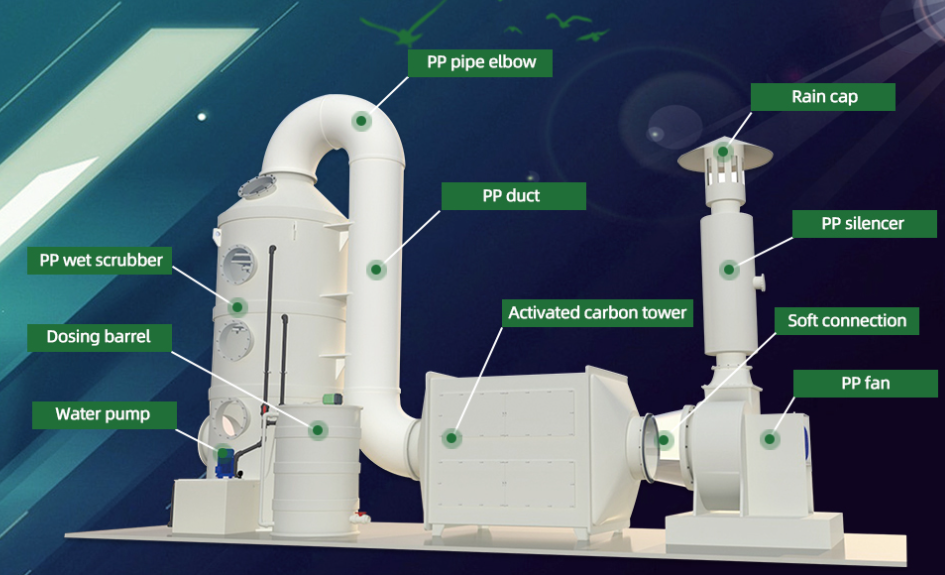Introduction of organic waste gas treatment:
Organic waste gas treatment refers to the treatment of adsorption, filtration and purification of organic waste gas generated in the industrial production process. Usually, organic waste gas treatment includes formaldehyde organic waste gas treatment, benzene toluene xylene and other benzene series organic waste gas treatment, acetone methyl ketone organic waste gas treatment, ethyl acetate waste gas treatment, oil mist organic waste gas treatment, furfural organic waste gas treatment, styrene, acrylic acid Organic waste gas treatment, resin organic waste gas treatment, additive organic waste gas treatment, paint mist organic waste gas treatment, Tian Nashui organic waste gas treatment and other air purification treatment methods containing organics such as carbon, hydrogen and oxygen.
Characteristics of organic waste gas:
Organic waste gas is generally flammable, explosive, toxic and harmful, insoluble in water, soluble in organic solvents, and difficult to handle.
Organic waste gas treatment method:
1. Condensation recovery method: The organic waste gas is directly introduced into the condenser, and the valuable organic matter can be recovered through adsorption, absorption, dissolution and separation. This method is suitable for working conditions with a high concentration of organic waste gas, low temperature and low air volume, and requires auxiliary refrigeration equipment. It is mainly used in the pharmaceutical and chemical industries and is rarely used by printing companies.
2. Adsorption method:
(1) Direct adsorption method: The organic waste gas is adsorbed by activated carbon, and the purification rate can reach more than 95%. The equipment is simple and the investment is small. However, the frequent replacement of activated carbon increases the working procedures of loading, unloading, transportation, and replacement, resulting in increased operating costs;
(2) Adsorption-recovery method: Use fiber activated carbon to absorb organic waste gas, and then blow it back with superheated steam after reaching saturation for desorption and regeneration; this method requires the provision of necessary steam;
(3) Adsorption-catalytic combustion method: This method combines the advantages of the adsorption method and the catalytic combustion method, adopts a new type of adsorption material (honeycomb activated carbon) for adsorption, and introduces hot air for desorption and analysis after reaching saturation, and the exhaust gas after desorption Introducing flameless combustion in a catalytic combustion bed, thoroughly purifying it, and circulating hot gas in the system, greatly reducing energy consumption. This method has the characteristics of stable and reliable operation, reduced investment, reduced operating costs, and convenient maintenance. It is suitable for the treatment of large air volume and low concentration exhaust gas. It is currently a relatively mature and practical method for organic exhaust gas treatment in China.
3. Direct combustion method: Use auxiliary fuels such as gas or oil to heat the mixed gas to decompose harmful substances into harmless substances under the action of high temperature; this method has a simple process and low investment and is suitable for high-concentration, low-volume exhaust gas. , But has higher requirements on safety technology and operation.
4. Catalytic combustion method: The exhaust gas is heated and catalytically burned into harmless and odorless carbon dioxide and water; this method has low light-off temperature, energy-saving, high purification rate, convenient operation, small area, large investment, and application For high temperature or high concentration organic waste gas.
5. Absorption method: Generally, physical absorption is used, that is, the exhaust gas is introduced into the absorption liquid for purification. After the absorption liquid is saturated, it is heated, analyzed, and condensed for recovery; this method is suitable for the treatment of atmospheric, low-temperature, and low-concentration exhaust gas, but it needs to be equipped Heating analysis and recovery device, with large equipment volume and high investment.
6. Nano-micro electrolytic oxidation method: Nano-micro electrolysis purification technology uses nano-scale processed piezoelectric materials. When there is a certain humidity, the electrical adsorption of nano-micro electrolytic materials can be generated through the micro-electrolysis electric field and release a large amount of hydroxyl groups. Negative ions purify the aerobic pollutants in the gas, which can not only remove most of the organic matter in the air but also analyze inorganic odors such as ammonia nitrogen and hydrogen sulfide.
7. Thermal combustion method: The use of regenerative thermal oxidation furnace RTO for organic waste gas treatment can achieve the dual effect of high efficiency and energy saving. It is suitable for the treatment of organic waste gas in a wide range and has high treatment efficiency. RTO equipment has been widely used in coating, printing, spraying, medicine and other industries.
